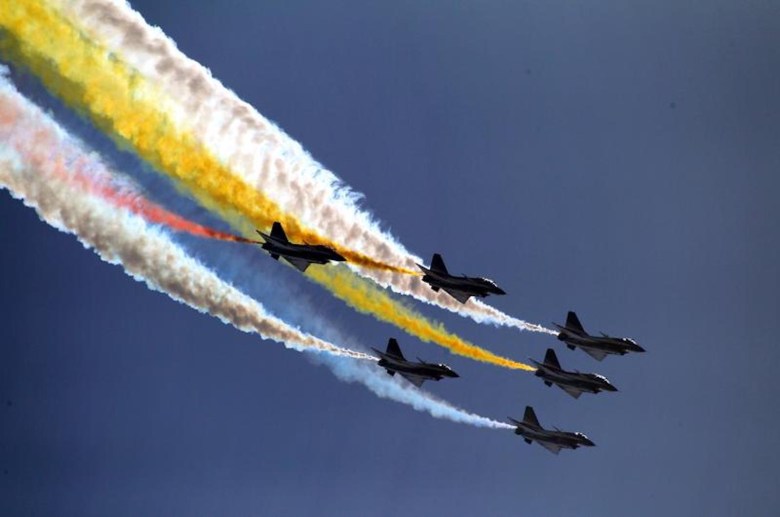Politics
US and China Ramp Up Manned Fighter Programs Amid Drone Debate

The competition for air supremacy between the United States and China is intensifying as both nations focus on enhancing their manned fighter capabilities. Recent reports indicate that China’s People’s Liberation Army Air Force (PLAAF) has achieved a significant milestone by fielding over 300 Chengdu J-20 stealth fighters. This development highlights China’s commitment to expanding its fifth-generation combat aircraft fleet, particularly in light of the US extending the operational life of its F-22 Raptors.
In mid-September, four J-20s, including the landmark 300th production aircraft, identified by its construction number “CB10300,” were showcased at an air show in Changchun, located in Jilin province. Analysts noted that the PLAAF has added at least 50 new aircraft since June 2024, reflecting a swift delivery pace. China now boasts a stealth fleet that rivals the US Air Force’s 180 F-22 Raptors and more than 240 F-35As, although the US total increases when including Marine Corps and Navy aircraft.
Strategic Enhancements in the US
In response to China’s advancements, the US is not standing still. According to reports from The War Zone, Lockheed Martin is advocating for the US Air Force to expand its F-22 upgrade program. This would include 35 older Block 20 jets currently utilized for training. The aim is to bolster combat readiness as uncertainty looms over the timeline for the F-22’s replacement. OJ Sanchez, Vice President of Skunk Works, emphasized the importance of modernizing these sidelined aircraft during the recent Air, Space & Cyber Conference in Maryland.
The push for upgrades comes amid pressure from US Congress and operational concerns, as the Air Force lacks a definitive successor to the F-22. Proposed enhancements would extend the aircraft’s viability into the 2040s, improving stealth, sensors, and capabilities for crewed-uncrewed teaming. Notably, the F-22s are expected to lead the upcoming Collaborative Combat Aircraft (CCA), with necessary technologies being integrated as part of the Next Generation Air Dominance (NGAD) program.
Moreover, the US has commenced production of the F-47, its first sixth-generation fighter jet, which is scheduled to make its maiden flight in 2028. General David Allvin, US Air Force Chief of Staff, confirmed this development at the Air, Space, and Cyber Conference. The F-47, designed by Boeing under the NGAD initiative, will incorporate advanced features such as enhanced stealth, hypersonic weapon capabilities, artificial intelligence, and integration with unmanned drones.
The Role of Manned Fighters in Modern Warfare
Both nations are investing heavily in unmanned systems, yet the focus on enhancing manned fighters underscores the limitations of drone technology. Experts have raised concerns regarding the effectiveness of unmanned loyal wingman drones, citing significant challenges related to cost, survivability, and artificial intelligence capabilities. Jay Stout highlighted in a July 2025 article that developing unmanned aircraft with performance levels comparable to manned fighters often results in similar costs, while still depending on vulnerable communication links.
Similarly, Chinese analysts have expressed worries over their unmanned aerial vehicles (UAVs), which are seen as susceptible to issues such as datalink fragility and tactical inflexibility. In a May 2025 CNA article, Eleanor Harvey and Timothy Ditter noted that these vulnerabilities could compromise the operational effectiveness of Chinese UAVs.
A February 2025 article by Rohith Stambamkadi for the Institute for Security and Development Policy (ISDP) further argues that drones alone cannot achieve air superiority due to fundamental limitations in adaptability and survivability. Stambamkadi emphasizes the importance of human pilots in making real-time decisions in dynamic combat environments, pointing out that drones typically lack the endurance necessary for effectiveness in contested airspace.
As the competition evolves, both the US and China are exploring manned-unmanned teaming (MUM-T) concepts to address the shortcomings of their respective platforms. A report by Shanshan Mei from RAND in August 2025 indicates that China views MUM-T as integral to future combat operations, focusing on augmenting manned platforms with advanced software and algorithms while maintaining strict control over decision-making.
Conversely, US strategies, as outlined by Bryan Clark and Dan Patt in a September 2025 Hudson Institute report, aim to utilize uncrewed systems as a means to absorb risk and create opportunities for crewed aircraft. The Pacific airspace, characterized by missile threats, underscores the necessity of having crewed fighters take the lead while unmanned support extends their operational reach.
The ongoing advancements in both manned and unmanned systems underline the critical role of human judgment in combat scenarios. With the potential for drones to operate remotely and facilitate various tasks in combat, the future of air dominance may hinge on the ability of pilots to effectively command these technologies while ensuring adaptability in rapidly changing environments.
-

 Business5 months ago
Business5 months agoKenvue Dismisses CEO Thibaut Mongon as Strategic Review Advances
-

 Lifestyle4 months ago
Lifestyle4 months agoHumanism Camp Engages 250 Youths in Summer Fest 2025
-

 Sports4 months ago
Sports4 months agoDe Minaur Triumphs at Washington Open After Thrilling Comeback
-

 Sports5 months ago
Sports5 months agoTupou and Daugunu Join First Nations Squad for Lions Clash
-

 Top Stories5 months ago
Top Stories5 months agoColombian Senator Miguel Uribe Shows Signs of Recovery After Attack
-

 World5 months ago
World5 months agoASEAN Gears Up for Historic Joint Meeting of Foreign and Economic Ministers
-

 Health4 months ago
Health4 months agoNew Study Challenges Assumptions About Aging and Inflammation
-

 Business5 months ago
Business5 months agoOil Prices Surge Following New EU Sanctions on Russia
-

 Entertainment4 months ago
Entertainment4 months agoDetaşe-Sabah Violin Ensemble Captivates at Gabala Music Festival
-

 Entertainment4 months ago
Entertainment4 months agoBaku Metro Extends Hours for Justin Timberlake Concert
-

 Top Stories5 months ago
Top Stories5 months agoRethinking Singapore’s F&B Regulations Amid Business Closures
-

 Business5 months ago
Business5 months agoU.S. House Approves Stablecoin Bill, Sends to Trump for Signature









